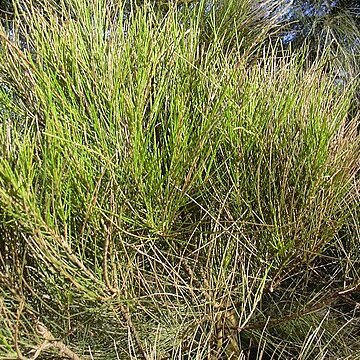Trees , 8-20 m, frequently producing root suckers. Bark gray-brown, finely fissured and scaly. Branchlets drooping; segments 8-20 × 0.9-1.2 mm, glabrous, occasionally waxy; longitudinal ridges flat to slightly rounded-convex; teeth usually marcescent, 12-17, erect, 0.6-0.9 mm. Young permanent shoots with long-recurved teeth. Flowers unisexual, staminate and pistillate on different plants. Staminate spikes 1.2-4 cm, 7-10 whorls per cm; anthers ca. 0.8 mm. Infructescences rust-colored to white-pubescent, becoming glabrous; peduncles 3-12 mm; infructescence body 9-18 × 7-9 mm; bracteoles broadly acute. Samaras 3.5-5 mm.
Tree 8–20 m high or rarely shrub to c. 2 m, frequently producing root suckers. Bark finely fissured and scaly, grey-brown. Teeth on new shoots long-recurved. Branchlets spreading to drooping, to 38 cm long; articles 8–20 mm long, 0.9–1.2 mm diam., glabrous, occasionally waxy; phyllichnia flat to slightly rounded; teeth 12–17, rarely to 20, erect, 0.6–0.9 mm long, usually marcescent. Male spikes 1.2–4 cm long, 7–10 whorls per cm; anther c. 0.8 mm long. Cones ferruginous-to white-pubescent, becoming glabrous; peduncle 3–12 mm long; cone body 9–18 mm long, 7–9 mm diam.; bracteoles broadly acute. Samara 3.5–5.0 mm long.
Trees dioecious, to 20 m tall. Trunk to 35 cm d.b.h.; bark grayish brown or grayish black, finely fissured and scaly, pale yellow adaxially. Ultimate branchlets ascending to pendulous, grayish green or glaucous green, rather long, to 1 m, 0.9-1.4 mm in diam.; articles 1-1.8 cm, slightly swollen at apex. Leaves erect but those of new shoots strongly recurved, 12-17 per whorl, narrowly lanceolate. Male inflorescences 1-3 cm. Cones broadly ellipsoid to subglobose, 1.2-2 cm, truncate at both ends; apex of bracteoles broadly acute to obtuse. Samaras 4-6 mm including wing. Fl. Mar-Apr, fr. Jun-Sep. 2n = 18*.
Dioecious, small to large tree up to 15 m high, with branches ± erect. Young branchlets glabrous, relatively stout (1-1.5 mm diam.), rounded with as many flat ribs as lf-teeth. Lf-teeth of adult branchlets in whorls of (12)-14-16-(17), lanceolate, brown at base, 0.66-1 mm long; tip pale white or grey, usually withering. ♂ fls in terminal spikes (10)-15-30 mm long; whorls of bracts overlapping when fls mature. Cone ellipsoid or subglobose and flattened at apex, 10-15 mm long; margins of valves acute or with a short blunt point; seeds dull, light whitish brown, 4-6 mm long, with pale membranous wing.
A small sturdy tree. It grows 2-10 m tall and spreads 2-10 m wide. It often has root suckers. The small branches are 10-35 cm long. They are 0.9-1.5 mm wide. They have 12-17 ridges along them. There are tooth like leaves at the nodes. The leaves are 0.5-0.9 mm long. The leaves are grey-green. The flowers are reddish-brown. The cones are small. They are 9-18 mm long and 8-13 mm wide.
Deciduous branchlets 0.7–0.9 mm. in diam. with 14–15 inconspicuous ribs; scale leaves appressed, banded as in C. cunninghamiana, free pan 0.5–0.7 x 0.15 mm.
Male inflorescence c. 2 mm. in diam., whorls of bracts 10-many, flowers c. 14 per whorl; bracts ± reflexed, free for 1.6–2 mm., banded as in leaves.
Infructescence 10–15 x 10–15 mm., cylindrical or depressed-ovoid; valve backs, where visible, with several fine longitudinal ridges.
Persistent branches with c. 13 ribs; free parts of scale leaves c. 2.5 mm. long, reflexed.
Samaras pale brownish, not shiny.
Tree.


